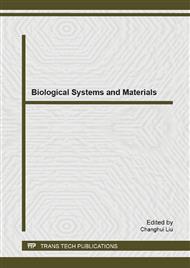p.75
p.80
p.86
p.91
p.96
p.104
p.110
p.116
p.123
Optimization of Ferment Condition of ε-Poly-L-Lysine by Response Surface Methodology
Abstract:
Streptomyces albus Y07, a strain which could produce ε-Poly-L-lysine (ε-PL) had been screened in our previous study. The fermentation conditions for ε-Poly-L-lysine production were further optimized through response surface method in this work. A central composite design was adopted to study the effect of culture volume, shaking speed, initial culture pH, as well as inoculation amount on ε-PL production. A quadratic polynomial equation for ε-Poly-L-lysine production was obtained by multiple regression analysis. The equation was as follow: The accuracy and general availability of the polynomial model were proved to be adequate with R2 Pre = 0.8373. The optimized conditions were as follows: culture volumn: 50/500ml, culture pH = 7, inoculation amount: 10% of the total culture volume, shaking speed: 180rpm. Under the optimized conditions, the ε-PL production reached 1.085g / L. And the validity of the predicited model was further confirmed through verification experiments..
Info:
Periodical:
Pages:
96-103
Citation:
Online since:
May 2014
Authors:
Price:
Сopyright:
© 2014 Trans Tech Publications Ltd. All Rights Reserved
Share:
Citation:


